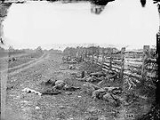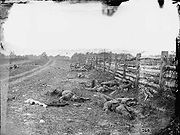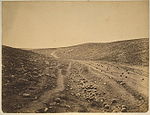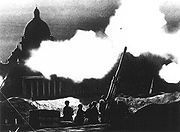
War photography
Encyclopedia

Photograph
A photograph is an image created by light falling on a light-sensitive surface, usually photographic film or an electronic imager such as a CCD or a CMOS chip. Most photographs are created using a camera, which uses a lens to focus the scene's visible wavelengths of light into a reproduction of...
s of armed conflict and life in war
War
War is a state of organized, armed, and often prolonged conflict carried on between states, nations, or other parties typified by extreme aggression, social disruption, and usually high mortality. War should be understood as an actual, intentional and widespread armed conflict between political...
-torn areas.
Although photographs can provide a more direct representation than painting
Painting
Painting is the practice of applying paint, pigment, color or other medium to a surface . The application of the medium is commonly applied to the base with a brush but other objects can be used. In art, the term painting describes both the act and the result of the action. However, painting is...
s or drawing
Drawing
Drawing is a form of visual art that makes use of any number of drawing instruments to mark a two-dimensional medium. Common instruments include graphite pencils, pen and ink, inked brushes, wax color pencils, crayons, charcoal, chalk, pastels, markers, styluses, and various metals .An artist who...
s, they are sometimes manipulated
Photo manipulation
Photo manipulation is the application of image editing techniques to photographs in order to create an illusion or deception , through analog or digital means.- Types of digital photo manipulation :...
, creating an image that is not objectively journalistic
Objectivity (journalism)
Parent article: Journalism ethics and standardsObjectivity is a significant principle of journalistic professionalism. Journalistic objectivity can refer to fairness, disinterestedness, factuality, and nonpartisanship, but most often encompasses all of these qualities.- Definitions :In the context...
.
History
Photography, presented to the public in 1839, was believed to create images that were accurate representations of the world. Photography was used to record historicalHistory
History is the discovery, collection, organization, and presentation of information about past events. History can also mean the period of time after writing was invented. Scholars who write about history are called historians...
information, but not always in the optimistic way that was conceived at the advent of the medium.
It was anticipated that photographers, supposedly not acting as active participants of war but as neutral partisan, would be able to bring their cumbersome photographic equipment into the battlefield and record the rapid action of combat
Combat
Combat, or fighting, is a purposeful violent conflict meant to establish dominance over the opposition, or to terminate the opposition forever, or drive the opposition away from a location where it is not wanted or needed....
. This was not the case, as the technical insufficiency of the photograph in recording movement was not considered. The daguerreotype
Daguerreotype
The daguerreotype was the first commercially successful photographic process. The image is a direct positive made in the camera on a silvered copper plate....
, an early form of photography that generated a single image using a silver
Silver
Silver is a metallic chemical element with the chemical symbol Ag and atomic number 47. A soft, white, lustrous transition metal, it has the highest electrical conductivity of any element and the highest thermal conductivity of any metal...
-coated copper
Copper
Copper is a chemical element with the symbol Cu and atomic number 29. It is a ductile metal with very high thermal and electrical conductivity. Pure copper is soft and malleable; an exposed surface has a reddish-orange tarnish...
plate, took a very long time to produce. This prevented action photography, as images took minutes to develop and could not be processed immediately.

Mexican–American War
The Mexican–American War, also known as the First American Intervention, the Mexican War, or the U.S.–Mexican War, was an armed conflict between the United States and Mexico from 1846 to 1848 in the wake of the 1845 U.S...
, in 1847, of the occupation of Saltillo. The first known war photographer is the Hungarian-Romanian Carol Popp de Szathmàri who took photos of various officers in 1853 and of war scenes near Olteniţa
Oltenita
Olteniţa is a city in Romania in the Călăraşi County on the left bank of the Argeş River where its waters reach the Danube through a network of streams and marshes.Oltenita stands just across the Danube from the Bulgarian city of Tutrakan.-History:...
and Silistra
Silistra
Silistra is a port city of northeastern Bulgaria, lying on the southern bank of the lower Danube at the country's border with Romania. Silistra is the administrative centre of Silistra Province and one of the important cities of the historical region of Southern Dobrudzha...
in 1854, during the Crimean War
Crimean War
The Crimean War was a conflict fought between the Russian Empire and an alliance of the French Empire, the British Empire, the Ottoman Empire, and the Kingdom of Sardinia. The war was part of a long-running contest between the major European powers for influence over territories of the declining...
. He created some 200 pictures albums, which he personally offered in 1855 to Napoleon III of France
Napoleon III of France
Louis-Napoléon Bonaparte was the President of the French Second Republic and as Napoleon III, the ruler of the Second French Empire. He was the nephew and heir of Napoleon I, christened as Charles Louis Napoléon Bonaparte...
and Queen Victoria of the United Kingdom
Victoria of the United Kingdom
Victoria was the monarch of the United Kingdom of Great Britain and Ireland from 20 June 1837 until her death. From 1 May 1876, she used the additional title of Empress of India....
. About 9 of his pictures survive today The French photographer Ernest Edouard de Caranza caught his countrymen in their camp near Varna
Varna
Varna is the largest city and seaside resort on the Bulgarian Black Sea Coast and third-largest in Bulgaria after Sofia and Plovdiv, with a population of 334,870 inhabitants according to Census 2011...
, in 1854. He was followed by Roger Fenton
Roger Fenton
Roger Fenton was a pioneering British photographer, one of the first war photographers.-Early life:Roger Fenton was born in Crimble Hall, Heap, Bury, Lancashire, 28 March 1819. His grandfather was a wealthy cotton manufacturer and banker, his father a banker and Member of Parliament...
, in 1855, although with his bulky equipment he was limited to posed still photographs or landscapes. He took a large van and an assistant, and returned to Britain with over 350 usable large format negatives.
In the late 1850s, Felice Beato
Felice Beato
Felice Beato , also known as Felix Beato, was an Italian–British photographer. He was one of the first people to take photographs in East Asia and one of the first war photographers. He is noted for his genre works, portraits, and views and panoramas of the architecture and landscapes of Asia and...
traveled to India to photograph scenes from the recent mutiny, and produced a number of images of the Siege of Lucknow
Siege of Lucknow
The Siege of Lucknow was the prolonged defense of the Residency within the city of Lucknow during the Indian Rebellion of 1857. After two successive relief attempts had reached the city, the defenders and civilians were evacuated from the Residency, which was abandoned.Lucknow was the capital of...
and the Siege of Delhi
Siege of Delhi
The Siege of Delhi was one of the decisive conflicts of the Indian rebellion of 1857.The rebellion against the authority of the British East India Company was widespread through much of Northern India, but essentially it was sparked by the mass uprising by the sepoys of the units of the Army which...
. Shortly thereafter, he went to China to record the aftermath of the Second Opium War
Second Opium War
The Second Opium War, the Second Anglo-Chinese War, the Second China War, the Arrow War, or the Anglo-French expedition to China, was a war pitting the British Empire and the Second French Empire against the Qing Dynasty of China, lasting from 1856 to 1860...
.
The inability of the early photograph to record a moving object lead to the practice of recreating scenes of battle, such as in the work of both Haley Sims and Alexander Gardner
Alexander Gardner (photographer)
Alexander Gardner was a Scottish photographer who moved to the United States in 1856 where he developed his profession. He is best known for his photographs of the American Civil War, American President Abraham Lincoln, and the execution of the conspirators to Lincoln's...
. They admittedly reconfigured scenes that took place during the American Civil War
American Civil War
The American Civil War was a civil war fought in the United States of America. In response to the election of Abraham Lincoln as President of the United States, 11 southern slave states declared their secession from the United States and formed the Confederate States of America ; the other 25...
(1861–65) in order to intensify the visual and emotional effects of battle. Alexander Gardner and Mathew Brady
Mathew Brady
Mathew B. Brady was one of the most celebrated 19th century American photographers, best known for his portraits of celebrities and his documentation of the American Civil War...
rearranged bodies of dead soldiers during the Civil War in order to create a clear picture of the atrocities associated with battle. In Soldiers on the Battlefield, 1862, Brady produced a controversial tableau of the dead within a desolate landscape. This work, along with Alexander Gardner’s 1863 work Home of a Rebel Sharpshooter were images, which, when shown to the public, brought home the horrific reality of war.
The Second Anglo-Afghan War
Second Anglo-Afghan War
The Second Anglo-Afghan War was fought between the United Kingdom and Afghanistan from 1878 to 1880, when the nation was ruled by Sher Ali Khan of the Barakzai dynasty, the son of former Emir Dost Mohammad Khan. This was the second time British India invaded Afghanistan. The war ended in a manner...
of 1878–80 was photographed by John Burke who traveled with the Anglo-British forces. This was a commercial venture with the hope of selling albums of war photographs.
Since early photographers were not able to create images of moving targets, they would record more sedentary aspects of war, such as fortifications, soldiers, and land before and after battle along with the re-creation of action scenes. Similar to battle photography, portrait
Portrait
thumb|250px|right|Portrait of [[Thomas Jefferson]] by [[Rembrandt Peale]], 1805. [[New-York Historical Society]].A portrait is a painting, photograph, sculpture, or other artistic representation of a person, in which the face and its expression is predominant. The intent is to display the likeness,...
images of soldiers were also often staged. In order to produce a photograph, the subject had to be perfectly still for a matter of minutes, so they were posed to be comfortable and minimize movement.
In the 20th century, photographers covered all the major conflicts, and many were killed as a consequence. One of the most famous was Robert Capa
Robert Capa
Robert Capa was a Hungarian combat photographer and photojournalist who covered five different wars: the Spanish Civil War, the Second Sino-Japanese War, World War II across Europe, the 1948 Arab-Israeli War, and the First Indochina War...
who covered the Spanish Civil War
Spanish Civil War
The Spanish Civil WarAlso known as The Crusade among Nationalists, the Fourth Carlist War among Carlists, and The Rebellion or Uprising among Republicans. was a major conflict fought in Spain from 17 July 1936 to 1 April 1939...
, the D-Day
D-Day
D-Day is a term often used in military parlance to denote the day on which a combat attack or operation is to be initiated. "D-Day" often represents a variable, designating the day upon which some significant event will occur or has occurred; see Military designation of days and hours for similar...
landings and the fall of Paris, and conflicts in the 1950s until his death by a landmine in Indochina in May 1954. The famous photograph of the flag-raising on Mount Suribachi on Iwo Jima
Iwo Jima
Iwo Jima, officially , is an island of the Japanese Volcano Islands chain, which lie south of the Ogasawara Islands and together with them form the Ogasawara Archipelago. The island is located south of mainland Tokyo and administered as part of Ogasawara, one of eight villages of Tokyo...
in 1945 was taken by photojournalist, Joe Rosenthal
Joe Rosenthal
Joseph John Rosenthal was an American photographer who received the Pulitzer Prize for his iconic World War II photograph Raising the Flag on Iwo Jima, taken during the Battle of Iwo Jima. His picture became one of the best-known photographs of the war.-Early life:Joseph Rosenthal was born on...
. Photojournalists continue to cover conflicts around the world.
Unlike paintings, which presented a single illustration of a specific event, photography offered the opportunity for an extensive amount of images to enter circulation. The proliferation of the photographic images allowed the public to be well informed in the discourses of war. The advent of mass-reproduced images of war were not only used to inform the public but they served as imprints of the time and as historical recordings. Mass-produced images did have consequences. Besides informing the public, the glut of images in distribution over-saturated the market, allowing viewers to develop the ability to disregard the immediate value and historical importance of certain photographs.
War photographers
Photographers who participate in this genre may find themselves placed in harm's way, and are sometimes killed trying to get their pictures out of the war arena. JournalistsJournalism
Journalism is the practice of investigation and reporting of events, issues and trends to a broad audience in a timely fashion. Though there are many variations of journalism, the ideal is to inform the intended audience. Along with covering organizations and institutions such as government and...
and photographers are protected by international conventions of armed warfare, but history shows that they are often considered targets by warring groups — sometimes to show hatred of their opponents and other times to prevent the facts shown in the photographs from being known. War photography has become more dangerous with the terrorist style of armed conflict as some terrorists target journalists and photographers. In the current Iraq War, several photographers have been captured and executed by terrorists
Terrorism
Terrorism is the systematic use of terror, especially as a means of coercion. In the international community, however, terrorism has no universally agreed, legally binding, criminal law definition...
or shot in the knee cap by armed insurgents. Several have also been killed by US fire; two Iraqi journalists working for Reuters were notably strafed by a helicopter during the July 12, 2007 Baghdad airstrike
July 12, 2007 Baghdad airstrike
The July 12, 2007 Baghdad airstrikes were a series of air-to-ground attacks conducted by a team of two United States Army AH-64 Apache helicopters in Al-Amin al-Thaniyah, in the district of New Baghdad in Baghdad, during the insurgency that followed the Iraq War.In the first strike "Crazyhorse 1/8"...
, yielding a scandal when Wikileaks
Wikileaks
WikiLeaks is an international self-described not-for-profit organisation that publishes submissions of private, secret, and classified media from anonymous news sources, news leaks, and whistleblowers. Its website, launched in 2006 under The Sunshine Press organisation, claimed a database of more...
published the video of the gun camera.
War photographers need not necessarily work near active fighting; instead they may document the aftermath of conflict. The German photographer Frauke Eigen
Frauke Eigen
Frauke Eigen is a German photographer, photojournalist and artist.-Kosovo war photographs:Eigen is featured in the Imperial War Museum London's 2011-2012 Women War Artists exhibition for her 2000 photographic exhibition Fundstücke Kosovo about war crimes in Kosovo...
created a photographic exhibition about war crimes in Kosovo which focussed on the clothing and belongings of the victims of ethnic cleansing
Ethnic cleansing
Ethnic cleansing is a purposeful policy designed by one ethnic or religious group to remove by violent and terror-inspiring means the civilian population of another ethnic orreligious group from certain geographic areas....
, rather than on their corpses. Eigen's photographs were taken during the exhumation of mass graves, and were later used as evidence by the War Crimes Tribunal in The Hague
The Hague
The Hague is the capital city of the province of South Holland in the Netherlands. With a population of 500,000 inhabitants , it is the third largest city of the Netherlands, after Amsterdam and Rotterdam...
.
Iconic images

- Raising the flag on Iwo JimaRaising the Flag on Iwo JimaRaising the Flag on Iwo Jima is a historic photograph taken on February 23, 1945, by Joe Rosenthal. It depicts five United States Marines and a U.S. Navy corpsman raising the flag of the United States atop Mount Suribachi during the Battle of Iwo Jima in World War II.The photograph was extremely...
- The Falling SoldierThe Falling SoldierThe Falling Soldier is a famous photograph taken by Robert Capa, understood to have been taken on September 5, 1936 and long thought to depict the death of a Republican, specifically an Iberian Federation of Libertarian Youth soldier during the Spanish Civil War, who was later identified as the...
- V–J day in Times SquareV–J day in Times SquareV-J Day in Times Square is a photograph by Alfred Eisenstaedt that portrays an American sailor kissing a young nurse in a white dress on V-J Day in Times Square on August 14, 1945. The photograph was published a week later in Life magazine among many photographs of celebrations around the country...
See also
- Embedded journalism and War correspondentWar correspondentA war correspondent is a journalist who covers stories firsthand from a war zone. In the 19th century they were also called Special Correspondents.-Methods:...
- Damien ParerDamien ParerDamien Peter Parer was an Australian war photographer. He became famous for his war photography of the Second World War, and was killed by Japanese machinegun fire at Peleliu, Palau. He married Elizabeth Marie Cotter on 23 March 1944, and his son, producer Damien Parer, was born after his father...
, Kokoda TrackKokoda TrackThe Kokoda Trail or Track is a single-file foot thoroughfare that runs overland — in a straight line — through the Owen Stanley Range in Papua New Guinea...
, Kokoda Front Line! - Photographers of the American Civil War
- PhotojournalismPhotojournalismPhotojournalism is a particular form of journalism that creates images in order to tell a news story. It is now usually understood to refer only to still images, but in some cases the term also refers to video used in broadcast journalism...
- War artistWar artistA war artist depicts some aspect of war through art; this might be a pictorial record or it might commemorate how "war shapes lives." War artists have explored a visual and sensory dimension of war which is often absent in written histories or other accounts of warfare.- Definition and context:A...
Works
- Regarding the Pain of OthersRegarding the Pain of OthersRegarding the Pain of Others was Susan Sontag's last published book before her death in 2004. It is regarded by many to be a follow-up or addendum to On Photography, despite the fact that the two books have radically different opinions about photography. This long essay is especially interested in...
- War PhotographerWar PhotographerWar Photographer is a documentary by Christian Frei about the photographer James Nachtwey. As well as telling the story of an iconic man in the field of war photography, the film addresses the broader scope of ideas common to all those involved in war journalism, as well as the issues that they...
Further reading
- Capa, Robert (1999). Heart of Spain: Robert Capa's photographs of the Spanish Civil War: from the collection of the Museo Nacional Centro de Arte Reina Sofía. [Denville, N.J.]: Aperture Foundation, Inc. ISBN 0893818313
- Harris, David (1999). Of battle and beauty: Felice Beato's photographs of China. Santa Barbara, CA: Santa Barbara Museum of Art. ISBN 0899511015
- Hodgson, Pat (1974). Early war photographs. Reading: Osprey Publishing. ISBN 085045221X
- Katz, D. Mark (1991). Witness to an era: the life and photographs of Alexander Gardner: the Civil War, Lincoln, and the West. New York, N.Y.: Viking. ISBN 0670828203
- James, Lawrence (1981). Crimea 1854-56: the war with Russia from contemporary photographs. New York: Van Nostrand Reinhold. ISBN 0442245696
- Lewinski, Jorge (1978). The camera at war: a history of war photography from 1848 to the present day. London: W. H. Allen. ISBN 0491024851
External links
- PBS on war photography
- War Photographer (Documentary)
- At War: Photographers' Best Shots - slideshow by Life magazine
- Anne S. K. Brown Military Collection, Brown University Library Includes war photographs by Roger Fenton, Felice Beato, Alexander Gardner, Matthew brady and others.
- An Eyemo camera used in 1942 by Damien Parer filming the Academy Award-winning documentary, Kokoda Front Line!, in New Guinea is held at National Museum Australia Canberra
- Booknotes interview with Susan Moeller on Shooting War: Photography and the American Experience of Combat, April 23, 1989.

